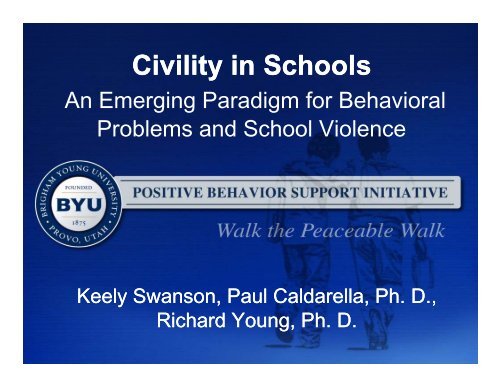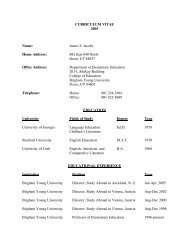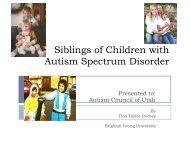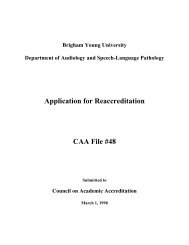Civility in Schools - McKay School of Education
Civility in Schools - McKay School of Education
Civility in Schools - McKay School of Education
Create successful ePaper yourself
Turn your PDF publications into a flip-book with our unique Google optimized e-Paper software.
<strong>Civility</strong> <strong>in</strong> <strong>in</strong> <strong><strong>School</strong>s</strong><br />
<strong><strong>School</strong>s</strong><br />
An Emerg<strong>in</strong>g Paradigm for Behavioral<br />
Problems and S<strong>School</strong><br />
Violence<br />
Keely Swanson, Paul Caldarella, Ph. D.,<br />
Ri Richard h d Y Young, Ph Ph. D D.
Objectives<br />
• What is civility?<br />
• Why is civility important?<br />
• Why should schools teach civility?<br />
• How could schools teach civility?
What is <strong>Civility</strong>?
<strong>Civility</strong> Def<strong>in</strong>ed<br />
• Modern: Modern ode : courtesy, cou tesy, po politeness, te ess,<br />
consideration, decorum<br />
(H<strong>in</strong>ckley, (Hi (H<strong>in</strong>ckley, kl 2000 2000; P Peck, k 2002 2002, F Ferriss, i 2002)<br />
• Historical Historical: : ability to work as a citizen, a<br />
sense <strong>of</strong> f membership b hi i <strong>in</strong> a community it<br />
with its attendant rights and<br />
responsibilities (Shulman & Carey, 1984; Boyd, 2006)
<strong>Civility</strong> Def<strong>in</strong>ed<br />
• Proximate Proximate: : politeness or absence <strong>of</strong><br />
f<br />
rudeness with<strong>in</strong> <strong>in</strong>teractions with others<br />
• Diffuse Diffuse: : regard for the effects <strong>of</strong> our<br />
actions on others and the spaces we<br />
share with them<br />
(Fyfe, Bannister, & Kearns, 2006)
<strong>Civility</strong> Def<strong>in</strong>ed<br />
• Polite behaviors that show<br />
respect toward a person <strong>in</strong><br />
order to ma<strong>in</strong>ta<strong>in</strong> social<br />
harmony and recognize<br />
the humanity <strong>of</strong><br />
that person
• Awareness<br />
(Forni, 2002)<br />
• Self Self-control control<br />
(Ferriss, 2002; Kuhlenschmidt, 1999)<br />
• Empathy<br />
Elements <strong>of</strong> <strong>Civility</strong><br />
(Kahn & Lawhorne, 2003; Schaefer, 1995; Berman, 1998)<br />
• R Respect t<br />
(H<strong>in</strong>ckley, 2000; Boyd, 2006; Marks, 1996; Youniss & Yates, 1999)
• Moral o a <strong>Education</strong> ducat o<br />
• Character <strong>Education</strong><br />
• Civic Civic <strong>Education</strong><br />
• Social Skills Tra<strong>in</strong><strong>in</strong>g<br />
Related Fields
Positive Behavior Support (PBS)
Why y is <strong>Civility</strong> y<br />
Important? p
Intr<strong>in</strong>sic Value <strong>of</strong> <strong>Civility</strong><br />
• If f we agree that all<br />
human be<strong>in</strong>gs are <strong>of</strong><br />
worth, then we have an<br />
obligation obligation to behave<br />
civilly toward all<br />
(Boyd, 2006; Forni, 2002; H<strong>in</strong>ckley, 2000; Youniss & Yates, 1999)<br />
• Personal satisfaction (H<strong>in</strong>ckley, 2000)
The Modern Call for <strong>Civility</strong><br />
• Anecdotal op<strong>in</strong>ion vs. empirical data<br />
• Advertisements and other media model<br />
uncivil behaviors (Leo, 1996)<br />
• Many young adults have difficulty<br />
th<strong>in</strong>k<strong>in</strong>g <strong>in</strong> terms <strong>of</strong> the whole<br />
community (Schaefer, (Schaefer (Schaefer, 1995)
<strong>School</strong> Violence<br />
• 10% <strong>of</strong> males males and 6% <strong>of</strong> females reported threat or<br />
<strong>in</strong>jury from weapon on school grounds (Mayer, 2008)<br />
• National Center for <strong>Education</strong>al Statistics (2007)<br />
reports<br />
-86% 86% <strong>of</strong> schools reported at least<br />
one theft, violent crime, or other<br />
crime (total (total 2 2.2 2 million crimes)<br />
-Students Students 12-18yrs: 12 18yrs:<br />
4% reported victimization<br />
3% reported reported theft<br />
1% reported violent victimization<br />
In past 6 months
Why Should<br />
<strong><strong>School</strong>s</strong> Teach<br />
Ci <strong>Civility</strong>?<br />
ilit ?
Prevention <strong>of</strong> <strong>School</strong> Violence<br />
• Physical precautions are not enough to<br />
create a safe school (Mayer, 2008)<br />
• <strong>Civility</strong> as a tool to alleviate negativity <strong>in</strong><br />
schools (Hatch, 1998)<br />
• <strong>Civility</strong> to reduce<br />
acts <strong>of</strong> violence<br />
(Feldman, 2001; O’Mara, 2007;<br />
Hatch, , 1998; ; Peck, , 2002<br />
Kahn & Lawhorne, 2003)
“Acts <strong>of</strong> violence are <strong>of</strong>ten the result <strong>of</strong><br />
an exchange <strong>of</strong> acts <strong>of</strong> rudeness that<br />
spiral i l out t <strong>of</strong> f control. t l Disrespect Di t can l lead d<br />
to bloodshed. By keep<strong>in</strong>g the levels <strong>of</strong><br />
<strong>in</strong>civility down down, we keep the levels <strong>of</strong><br />
violence down. . . . If we teach<br />
youngsters y g <strong>of</strong> all walks <strong>of</strong> life how to<br />
manage conflict with civility civility-based based<br />
relational skills, we will have a less<br />
uncivil i il society, i t a l less violent i l t one.” ”<br />
-P. P. M. Forni<br />
(as quoted <strong>in</strong> O’Mara, 2007)
<strong>Civility</strong> <strong>in</strong> <strong><strong>School</strong>s</strong><br />
• Modern education f focuses<br />
largely on academic <strong>in</strong>struction<br />
(Mourad, 2001; Berman, 1998; Peck, 2002)<br />
• Teach<strong>in</strong>g civility <strong>in</strong><br />
schools can encourage a<br />
more civil civil society<br />
(Hatch, 1998)
Public <strong>Education</strong> Historically<br />
• Aimed to prepare students to nurture<br />
civil society by teach<strong>in</strong>g them to be<br />
good citizens (Peck, 2002)<br />
• <strong>Civility</strong> y and manners were valued<br />
equally with academic material (Berman, 1998)
McGuffey Readers<br />
• U Used d f from 1830’ 1830’s t to 1920’ 1920’s<br />
• Helped students learn to read while<br />
expos<strong>in</strong>g i th them t to culture lt and d civility i ilit<br />
• Emphasized character, moral<br />
<strong>in</strong>tegrity, and <strong>in</strong>dividual responsibility<br />
• Along with the Bible, they were the sole<br />
source <strong>of</strong> enlightenment <strong>in</strong> many homes<br />
(See (See Peck Peck, 2002; Field Field, 1997)
<strong>Civility</strong> <strong>in</strong> <strong><strong>School</strong>s</strong><br />
• A need d t to re<strong>in</strong>tegrate i t t some <strong>of</strong> f what h t has h<br />
been removed from public education<br />
• C Comb<strong>in</strong>ation bi ti <strong>of</strong> f current t<br />
curriculum with<br />
early ideals <strong>of</strong><br />
civility
Tw<strong>of</strong>old Purpose <strong>of</strong><br />
Teach<strong>in</strong>g <strong>Civility</strong><br />
• Buffer aga<strong>in</strong>st school violence<br />
• Serve Serve to develop future citizens
How Could<br />
<strong><strong>School</strong>s</strong> Teach<br />
Ci <strong>Civility</strong>?<br />
ili ?
Suggestions for Improv<strong>in</strong>g <strong>Civility</strong><br />
• Expla<strong>in</strong> the rationale <strong>of</strong> civility<br />
• Make expectations clear (Burns, 2003)<br />
• Increase adult civility (Ludick, 2001)<br />
• Help students be more aware<br />
<strong>of</strong> their community’s needs<br />
(Boyd (Boyd, 2006; 2006; Berman Berman, 1998)<br />
• Teach empathy & perspective<br />
tak<strong>in</strong>g (Berman, Berman, 1998; Kahn & Lawhorne, 2003)
Suggested <strong>Civility</strong> Interventions<br />
• Tra<strong>in</strong><strong>in</strong>g <strong>in</strong> problem problem-solv<strong>in</strong>g, problem solv<strong>in</strong>g, social skills,<br />
anger management, self self-esteem esteem<br />
(Stover, 1999)<br />
• Integrate themes <strong>of</strong> civility <strong>in</strong>to academic<br />
curriculum (Nilsen, 2008)<br />
• Make students aware <strong>of</strong> actual beliefs <strong>of</strong> their<br />
peers (Stiles & Tyson, 2008)<br />
• Build rapport between students and faculty<br />
(Stover, 1999)<br />
• E Empower students t d t to t take t k a stand t d aga<strong>in</strong>st i t<br />
harassment and hurtful speech (Wessler, 2008)
<strong>Civility</strong> and Adolescents<br />
• Secondary students are will<strong>in</strong>g to learn<br />
skills for resolv<strong>in</strong>g differences (Hatch, 1998)<br />
• Creat<strong>in</strong>g social ties and build<strong>in</strong>g<br />
community are ma<strong>in</strong> developmental<br />
needs (Schaefer, 1995)<br />
• Identity y formation (Youniss & Yates, 1999)<br />
• On the verge <strong>of</strong> full formal citizenship<br />
and cognitive cognitive ability to reason more<br />
effectively (Alth<strong>of</strong> & Berkowitz, 2006)
Caveats for <strong>Civility</strong><br />
• F Forc<strong>in</strong>g i civility i ilit<br />
• Discrim<strong>in</strong>atory civility<br />
• Limitations <strong>of</strong> civility
Need for Research<br />
• All <strong>in</strong>tervention ideas are supported<br />
anecdotally, but empirical data is very<br />
limited
Our Current Research<br />
• <strong>Civility</strong> survey created<br />
• Pilot Pilot tested tested with 10 school pr<strong>of</strong>essionals<br />
• Distributed via email to 2,000 college <strong>of</strong><br />
education alumni<br />
• Currently <strong>in</strong> the process <strong>of</strong> collect<strong>in</strong>g<br />
d data<br />
t
Sample Survey Questions<br />
• Held the door open for me at school<br />
• Responded <strong>in</strong>appropriately when they did not<br />
get what they wanted<br />
• S<strong>in</strong>cerely complimented others<br />
• Called others <strong>of</strong>fensive names<br />
• Left public areas <strong>in</strong> the school neat and clean<br />
• Inappropriately used a cell phone or other<br />
electronic devise <strong>in</strong> class
RReferences f<br />
Alth<strong>of</strong>, W. & Berkowitz M. W. (2006). Moral education and character education: Their relationship and roles <strong>in</strong> citizenship edu educat cation. ion.<br />
Journal <strong>of</strong> Moral <strong>Education</strong> <strong>Education</strong>, 35(4) 35(4), 495 495-518 495 518 518.<br />
Berman, S. H. (1998). The bridge to civility: Empathy, ethics, and service. <strong>School</strong> Adm<strong>in</strong>istrator, 55(5 55(5), ), 27 27-32. 32.<br />
Boyd, R. (2006). The value <strong>of</strong> civility? Urban Studies, 43 43, , 863-878. 863 878.<br />
Burns, M. T. (2003). The battle for civilized behavior: Let’s beg<strong>in</strong> with manners. Phi Delta Kappan, 84 84, , 546 546-549. 549.<br />
Feldmann Feldmann L. J.(2001). Classroom Classroom civility civility is is another <strong>of</strong> our <strong>in</strong>structor responsibilities. College Teach<strong>in</strong>g, Teach<strong>in</strong>g, 49(4), 49(4), 137 137-140. 137 140.<br />
Ferriss, A. L. (2002). Study<strong>in</strong>g and measur<strong>in</strong>g civility: A framework, trends, and scale. Sociological Inquiry, 72(3 72(3), ), 376-392. 376 392.<br />
Field, S. L. (1997). Citizens for a ‘new world order’: A Historical Perspective <strong>of</strong> Citizenship <strong>Education</strong> <strong>in</strong> the United States States. . In K.<br />
Kennedy (Ed.), Citizenship education and the modern state (pp137 (pp137-147). 147). London: The Falmer Press.<br />
Forni, P. M. (2002). Choos<strong>in</strong>g <strong>Civility</strong>: The Twenty Twenty-five five Rules <strong>of</strong> Considerate Conduct Conduct. . New York: St. Mart<strong>in</strong>’s Press.<br />
Fyfe N., Banister J., & Kearns A. (2006). (In)civility and the city. Urban Studies, 43 43, , 853-861. 853 861.<br />
Hatch D. R. (1998). Resolv<strong>in</strong>g differences: An education <strong>in</strong> civility (Master’s (Master’s Thesis, University <strong>of</strong> Texas at El Paso, 1998).<br />
H<strong>in</strong>ckley, G. B. (2000). Stand<strong>in</strong>g for Someth<strong>in</strong>g: 10 Neglected Virtues that Will Heal Our Hearts and Homes Homes. . New York: Times Books,<br />
Random House.<br />
Hoge Hoge, J. J D. D (2002). (2002) Character education education, citizenship education education, and the social studies studies. Social Studies, Studies 93(3), 93(3) 103 103-108 103 108 108.<br />
Kahn W. J. & Lawhorne, C. V. (2003). Empathy: The critical factor <strong>in</strong> conflict resolution and a culture <strong>of</strong> civility (report). West Chester<br />
PA: University <strong>of</strong> West Chester. Retrieved Retrieved August 2007, from EBSCOhost database. (ERIC Document reproduction Service No.<br />
ED479344).<br />
Kuhlenschmidt, S. L. (1999). Promot<strong>in</strong>g <strong>in</strong>ternal civility: Understand<strong>in</strong>g our beliefs about teach<strong>in</strong>g and students. New Directions for<br />
Teach<strong>in</strong>g and Learn<strong>in</strong>g, 77 77, , 13-22. 13 22.<br />
Leo, Leo, J. (1996, April 22). Foul words, foul culture. US News and World Report Report, , 73.<br />
Ludick, P. (2001). The culture <strong>of</strong> civility: The social cohesion <strong>of</strong> the social community. NAMTA Journal, 26(3), 33 33-53. 53.
RReferences f<br />
Marks, J. (1996, April 22). The American uncivil wars: How crude, rude, and obnoxious behavior has replaced good<br />
manners and why that hurts politics and culture. US News and World Report Report, , 66-72. 66 72.<br />
Mayer, M. M. J. (2008). Fact sheet #1: Overview <strong>of</strong> <strong>School</strong> Violence Prevention. Retrieved April 7, 7, 2008 from<br />
http://www.ncsvprp.org<br />
http://www.ncsvprp.org.<br />
Mourad, Roger, Jr., (2001). <strong>Education</strong> after Foucault: The question <strong>of</strong> civility. Teachers College Record, 103 103, , 739 739-759. 759.<br />
National Center for <strong>Education</strong>al Statistics. (2007). Indicators <strong>of</strong> school crime and safety: 2007. Retrieved April 11, 2008<br />
from http://nces.ed.gov/programs/crime<strong>in</strong>dicators/crime<strong>in</strong>dicators2007/<br />
Nilsen, A. P. (2008). <strong>Civility</strong>: The right th<strong>in</strong>g to teach <strong>in</strong> contentious times. English Journal (High school edition), 97(6), 65 65-<br />
69.<br />
O’Mara, R. (2007). <strong>Civility</strong> eng<strong>in</strong>eer. The Christian Scientist Monitor, 100(12), 20.<br />
Peck D. L. (2002). <strong>Civility</strong>: A contemporary context for a mean<strong>in</strong>gful historical concept. Sociological Inquiry, 72 72, , 358 358-375. 375.<br />
S Schaefer, h f L. L (1995) (1995). R Re<strong>in</strong>vent<strong>in</strong>g i ti civility. i ilit NAMTA J Journal, l 20 20, , 138 138-147. 147 147.<br />
Sherman, N. (2005). Of manners and morals. British Journal <strong>of</strong> <strong>Education</strong>al Studies, 53(3), 272 272-289. 289.<br />
Shulman, L. S. & Carey, N. B. (1984). Psychology and the limitations <strong>of</strong> <strong>in</strong>dividual rationality: Implications for the study <strong>of</strong><br />
reason<strong>in</strong>g and civility. Review <strong>of</strong> <strong>Education</strong>al Research, 54 54, , 501-524. 501 524.<br />
Stiles, M. & Tyson, y B. (2008). ( ) Market<strong>in</strong>g g civility. y American <strong>School</strong> Board Journal, 195(3), ( ) 36 36-37. 37.<br />
Stover, D. (1999). Rais<strong>in</strong>g students’ civil behavior. The <strong>Education</strong> Digest, 64(5), 11 11-13. 13.<br />
Walker, H. M., Ramsey, E., & Gresham F. M. (2004). Antisocial behavior <strong>in</strong> school: Evidence Evidence-based based practices (2<br />
Pacific Grove, CA: Brooks/Cole.<br />
Wessler, S. (2008). <strong>Civility</strong> speaks up. <strong>Education</strong>al Leadership, 66(1), 44 44-48. 48.<br />
Youniss, Y YYouniss, i J J. & Y Yates, t M M. (1999) (1999). Y Youth th service i and d moral moral-civic l civic i i id identity: tit A case f for everyday d morality. lit Ed <strong>Education</strong>al ti l<br />
Psychology Review, 11(4), 361 361-376. 376.<br />
(2 nd Ed.)
http://education.byu.edu/pbsi/<br />
For More Information, please contact:<br />
KKeely l SSwanson, kkeelyswanson@gmail.com l @ il<br />
Paul Caldarella, paul_caldarella@byu.edu<br />
Ri Richard h d YYoung, richard_young@byu.edu<br />
i h d @b d<br />
BYU PBS PBS-Initiative Initiative<br />
236 South 700 East<br />
Provo Provo, UT 84606<br />
801 801-377 377-0560 0560






